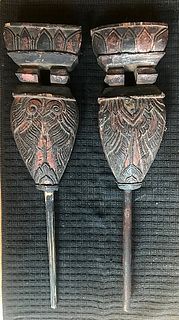11th C. Seljuk Lustreware & Stone-Paste Star Tile
Lot 46b
About Seller
Artemis Gallery
686 S Taylor Ave, Ste 106
Louisville, CO 80027
United States
Selling antiquities, ancient and ethnographic art online since 1993, Artemis Gallery specializes in Classical Antiquities (Egyptian, Greek, Roman, Near Eastern), Asian, Pre-Columbian, African / Tribal / Oceanographic art. Our extensive inventory includes pottery, stone, metal, wood, glass and textil...Read more
Categories
Estimate:
$3,000 - $4,500
Absentee vs Live bid
Two ways to bid:
- Leave a max absentee bid and the platform will bid on your behalf up to your maximum bid during the live auction.
- Bid live during the auction and your bids will be submitted real-time to the auctioneer.
Bid Increments
| Price | Bid Increment |
|---|---|
| $0 | $25 |
| $300 | $50 |
| $1,000 | $100 |
| $2,000 | $250 |
| $5,000 | $500 |
| $10,000 | $1,000 |
| $20,000 | $2,500 |
| $50,000 | $5,000 |
| $100,000 | $10,000 |
| $200,000 | $20,000 |
About Auction
By Artemis Gallery
Jul 1, 2021
Set Reminder
2021-07-01 10:00:00
2021-07-01 10:00:00
America/New_York
Bidsquare
Bidsquare : Antiquities | Asian | Ethnographic Art
https://www.bidsquare.com/auctions/artemis-gallery/antiquities-asian-ethnographic-art-7148
Featuring classical antiquities, ancient and ethnographic art from cultures encompassing the globe. Egyptian, Greek, Roman, Near Eastern, Asian, Pre-Columbian, Native American, African / Tribal, Oceanic, Spanish Colonial, Russian, Fossils, Fine Art, more! All legally acquired, legal to sell. Artemis Gallery info@artemisgallery.com
Featuring classical antiquities, ancient and ethnographic art from cultures encompassing the globe. Egyptian, Greek, Roman, Near Eastern, Asian, Pre-Columbian, Native American, African / Tribal, Oceanic, Spanish Colonial, Russian, Fossils, Fine Art, more! All legally acquired, legal to sell. Artemis Gallery info@artemisgallery.com
- Lot Description
Near East, Persia / Iran, Seljuk Dynasty, ca. 11th to 12th century CE. A lovely eight-pointed star tile made of stone-paste and lustreware. The scene features two seated figures wearing patterned blue robes and turbans or hats. Flowers and foliage patterns encircle the figures in hues of blue, white, and coppery brown tones. Around the outer edge is a blue ground with white Kufic script on the borders. The surface has a warm sheen from the metallic overglazing technique, characteristic of lustreware. Size: 7.75" Diameter x .5" W (19.7 cm x 1.3 cm)
In the later 8th century, Islamic empires in the west and China in the east battled each other for control of the incredibly lucrative trade along the Silk Road. At one point, the western powers captured a group of Tang Dynasty craftsmen, holding them in Baghdad for over 10 years. Tou-Houan, one of these captives, had been taken from his workshop near Samarqand after the Battle of Talas in 751 CE. After his return to China over a decade later, he wrote to his emperor that he and his countrymen had taught the Abbasids several important techniques. With this knowledge, Abbasid artisans created lustreware, a decorative technique that they likened to alchemy - it used a lead-based glaze, silver, and copper paint to create a golden sheen on ceramic surfaces. The warm glow of the motifs here are a perfect example of this "magical" technology. See several similar examples in the Khalili Collection, London, UK, the most famous collection of Islamic artwork in the world.
Provenance: private Vero Beach, Florida, USA collection acquired 1975
All items legal to buy/sell under U.S. Statute covering cultural patrimony Code 2600, CHAPTER 14, and are guaranteed to be as described or your money back.
A Certificate of Authenticity will accompany all winning bids.
We ship worldwide and handle all shipping in-house for your convenience.
#164043Repaired and restored from approximately 4 pieces. Chips and nicks to peripheries. Wear and discoloration to main image.Condition
- Shipping Info
-
All shipping is handled in-house for your convenience. Your invoice from Artemis Gallery will include shipping calculation instructions. If in doubt, please inquire BEFORE bidding for estimated shipping costs for individual items.
-
- Buyer's Premium



 EUR
EUR CAD
CAD AUD
AUD GBP
GBP MXN
MXN HKD
HKD CNY
CNY MYR
MYR SEK
SEK SGD
SGD CHF
CHF THB
THB












